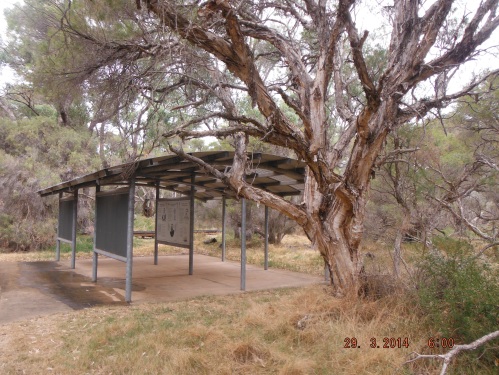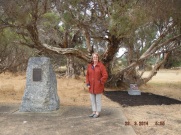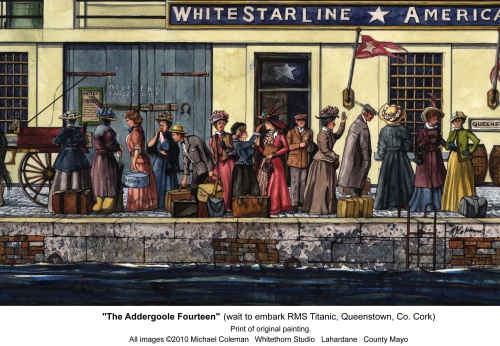
John Boyle O’Reilly Information Point, Leschenault Conservation Park, near Bunbury (Image ©thesilvervoice)
As Ireland commemorates the 150th Anniversary of the Fenian Rising of March 1867, it is fitting to note that thousands of miles away in Western Australia on this coming weekend of March 25th and 26th 2017, the John Boyle O’Reilly Association of Western Australia will once again pay homage to John Boyle O’Reilly, Irishman, Fenian, Poet, Journalist, Escaped Convict.
Although he was not active in the March 1867 Rising, it was Boyle O’Reilly’s Fenian membership that brought him to Australia as a convict in the first place. He was here for a relatively short time – from January 1868 to February 1869 – but nevertheless he is a hero in these parts and is remembered on an annual basis. The primary aims of the Association are to promote the life and literary works of John Boyle O’Reilly as well as his historical significance to Western Australia and the Bunbury area in particular.
I first encountered the John Boyle O’Reilly Association of Western Australia quite by chance when visiting the Leschenault Peninsula in Western Australia in 2014 with my friend Leith, who had wanted to show me where John Boyle O’Reilly ‘hung out’ while awaiting his escape from the penal colony. We arrived to discover that there was already a sizeable crowd there being addressed by various dignitaries. They had gathered at the John Boyle O ‘Reilly Memorial site to regale the gathered crowd with quotes and facts from his life and to celebrate his life and the work of the local community in raising awareness of their convict poet.
But who was John Boyle O’Reilly and why is he so revered in Australia?
“The world is large, when its weary leagues two loving hearts divide;
But the world is small, when your enemy is loose on the other side”
These words were spoken on June 28 1963, by the United States President John F. Kennedy in his address to the Oireachtas (Irish Parliament). He was quoting from the extensive work of poet, author, journalist and Fenian, John Boyle O’Reilly, who in all likelihood was as little known in Ireland then as now, but not as widely known as he ought to be. Historians and history buffs among us would have been aware of him and of his Fenian Brotherhood activities; others may have vaguely recalled the name from some long forgotten school history book. For a considerable number of us however, the name meant and still means very little.
My first (conscious) encounter with Boyle O’Reilly happened in Fremantle Prison in Western Australia in 2012. Fremantle Prison was the ‘Establishment’ in which convicts transported from Britain to the Colony of Western Australia were held.

Fremantle Prison (The Establishment) Housed convicts transported to Western Australia between 1850 and 1868 (Image c.thesilvervoice)
Now a World Heritage listed building, the ‘Establishment’ had at the time of my visit an exhibition that included a replica death mask of John Boyle O’Reilly that had been donated by the National Museum of Ireland.

Deathmask of John Boyle O’Reilly. A replica presented by the National Museum of Ireland
Born in 1844 at Dowth Castle in County Meath, John Boyle O’Reilly began a career as a journalist at the age of 15. He moved to England for a while as an apprentice and on his return to Dublin in 1863 he signed up with the 10th Hussars. Soon afterwards he became a member of the Irish Republican Brotherhood, or Fenians, who were rebelling against British rule. He actively recruited considerable numbers of new members from within his own regiment. When he was discovered, he was arrested. In June 1866 he was court martialled and on July 9, 1866 he was sentenced to death for his seditious activities. That sentence was immediately commuted to life imprisonment and subsequently to 20 years penal servitude. With other Fenian prisoners he was transferred to an English prison.

Boyle O’Reilly after his arrest.(Image Public Domain)
It was then decided that Fenian prisoners would be transported to Western Australia, and so in 1867, the Hougoumont left England with 62 Fenians among a consignment of 280 convicts on board. This historic voyage was to be the very last one transporting convicts to the penal Colonies of Australia.
During their time on the Hougoumont Boyle O’Reilly and others produced seven editions of a newspaper entitled ‘The Wild Goose’, containing poems, editorials and stories. Boyle O’Reilly later wrote “We published seven weekly numbers of it. Amid the dim glare of the lamp,the men at night would group strangely on extemporized seats. The yellow light fell down on the dark forms, throwing a ghastly glare on the pale faces of the men . .”
The Hougoumont arrived at Fremantle on January 9 1868 after a voyage lasting 89 days. Some weeks later, O’Reilly, prisoner number 9843, was assigned to works on the new road linking Bunbury and Vasse. He soon became an assistant to the head warder, Henry Woodman and he struck up a good friendship with the local Catholic priest, Fr.Patrick McCabe (a native of County Cavan) who offered to help him escape.
In the meantime, Boyle O’Reilly became romantically involved with Woodman’s daughter Jessie who became pregnant. The relationship ended unhappily and resulted in Boyle O’Reilly’s failed suicide attempt in December 1868, and subsequent depression. It was said that ”Boyle, poor Boyle, cried and cried in desperation for help.” Jessie married a local man in March 1869, probably to preserve her reputation. The fact of her pregnancy has only been confirmed in a letter discovered in San Franscisco in recent years, a letter written in May 1870 by John Boyle O Reilly in which he writes:
“If Cashman, or any of them knows anything about Miss Woodman I wish they would write it or tell you what it is . Was the child born? That’s the principal thing I want to know‘”
Fr. McCabe made arrangements with the captain of the Vigilant, a visiting whaling ship, to take Boyle O’Reilly on board and spirit him away from the Penal Colony. So on a February night in 1869, Boyle O’Reilly slipped away from the convict camp near Bunbury and made his way on foot to a pre-arranged meeting place with two others. From there they rode northwards for an hour and, picking up a rowing boat, they made their way out of the inlet and traveled northwards for about 12 miles. Here Boyle O’Reilly hid in the dunes, waiting for the Vigilant to leave port. When they spotted her, they rowed out to meet her but were devastated when the Vigilant sailed on, the captain apparently having reneged on the agreement he had made with Fr. McCabe. They had to return to shore and hide again while arrangements were made with another ship. After two weeks, they succeeded in making a deal with the captain of the American whaler Gazelle. O’Reilly and his friends met the Gazelle three miles out to sea on March 2 1869 and made good their escape. Boyle O’Reilly arrived in Philadelphia on November 23, 1869, one of the very few convicts ever to have escaped from the Western Australian penitentiary.
He settled in Boston and was employed by The Pilot newspaper. He married in 1872, and he and his wife Mary (Murphy) had four daughters. Boyle O’Reilly worked tirelessly lecturing and writing on the Irish question. He became influential and highly respected in the Irish Boston community. Over the next number of years he published, among other works, several popular books of poetry and a novel, Moondyne, based on his life as a convict.
His connection with Western Australia was not lost however as he was instrumental in planning the escape of 6 more Fenians in 1876. (This will be the subject of my next post).
On August 9 189o he was found dead, apparently having succumbed to an accidental overdose of sedative. He was only 46 years of age.
But his memory lives on in Western Australia where a dedicated band of admirers and scholars celebrate his life and his work, as they will do again this weekend. At the time of our visit in 2014, the Irish Ambassador Mr Noel White was in attendance together with the Irish Consul in Western Australia, Mr Marty Kavanagh.

The Irish Ambassador, The Irish Consul to WA , Ambassador’s son, and the author.
A memorial was unveiled to the late Dr Manea who did extraordinary work to raise awareness and appreciation of John Boyle O’Reilly in the area.

Memorial plaque in honour of Dr Manea. ‘This dreamer will live on forever’
Other West Australians dedicated to the cause are Fred Rea, Tony Costa and Peter Murphy who continue to promote all things John Boyle O’Reilly through their daily work. It would make you very proud to be Irish when you witness the passion these people and others in the area have for John Boyle O Reilly, their convict poet.
The Memorial to John Boyle O ‘Reilly at Leschenault

Image ©thesilvervoice
The inscription on the memorial reads:
In Proud Memory of
FENIAN JOHN BOYLE O’REILLY
Humanitarian, author, poet and lecturer.
Born Ireland 28th June 1844.
Died U.S.A 10th August 1890.
Absconded from a convict
road party, Cokelup Swamp
18th February 1869
and escaped from this area
on the whaling ship Gazelle
3rd March 1869.
Also dedicated to all convicts
who built , sweated and toiled
in this district.
Then here’s to brave John Boyle O’Reilly
who first blazed a trail over the sea
By escaping from Bunbury to Boston
An vowing his comrades to be free
Catalpa Ballad
Erected by the South West Irish Club and local community
Unveiled by Ambassador Designate to Ireland
Mr Brian Burke, 13th March, 1988.
I am indebted to Ian Kenneally, author of ‘From the Earth a Cry’, a biography of John Boyle O’Reilly for the ‘heads up’ on the discovery of the letter confirming that Jessie was indeed expecting Boyle O’Reilly’s child. His book is an excellent read and is highly recommended.

Published works of John Boyle O’Reilly
- Songs from the Southern Seas (1873) – a collection of poems
- Songs, Legends and Ballads (1878) – a collection of poems
- Moondyne (1879) – a novel based on his experiences as a convict in Western Australia
- An annotated edition of this work is available here through University College Cork’s Corpus of Electronic Texts (CELT).
- The Statues in the Block (1881) – a collection of poems
- In Bohemia (1886) – a collection of poems
- The Ethics of Boxing and Manly Sport (1888) – a treatise on health and physical exercise, later republished as Athletics and Manly Sport
References
Journal of the Cork Historical and Archaelogical Society, 1969, volume LXXIV
Convict Ship Newspaper, The Wild Goose, Re-discovered by Walter McGrath quoted
J. J. Roche, Life, Poems and Speeches of John Boyle O’Reilly, page 68










 Another image from Brian MacDomhnaill, whose interest in photographing abandoned houses led to the discovery of this picture of the Kennedys in an abandoned house in County Carlow. Interestingly, this photograph was taken in the deserted home of a catholic priest.
Another image from Brian MacDomhnaill, whose interest in photographing abandoned houses led to the discovery of this picture of the Kennedys in an abandoned house in County Carlow. Interestingly, this photograph was taken in the deserted home of a catholic priest.























 So, Santa Claus is not his area of expertise and it was a genuine mistake? BUT, Fr Hegarty, not only does Santa exist, he epitomizes the very message of Christmas that you were trying to convey!
So, Santa Claus is not his area of expertise and it was a genuine mistake? BUT, Fr Hegarty, not only does Santa exist, he epitomizes the very message of Christmas that you were trying to convey!








